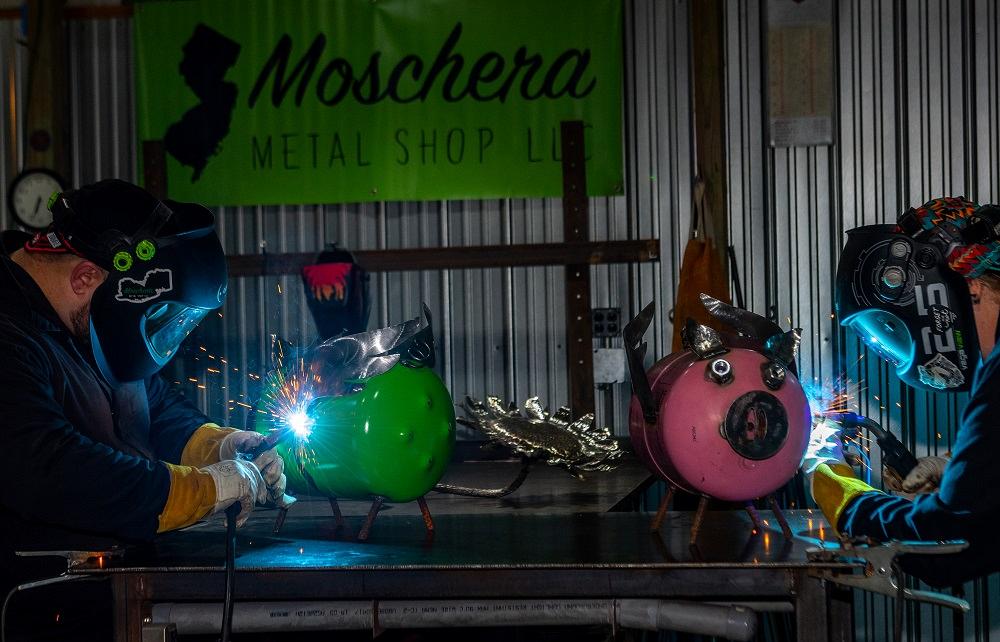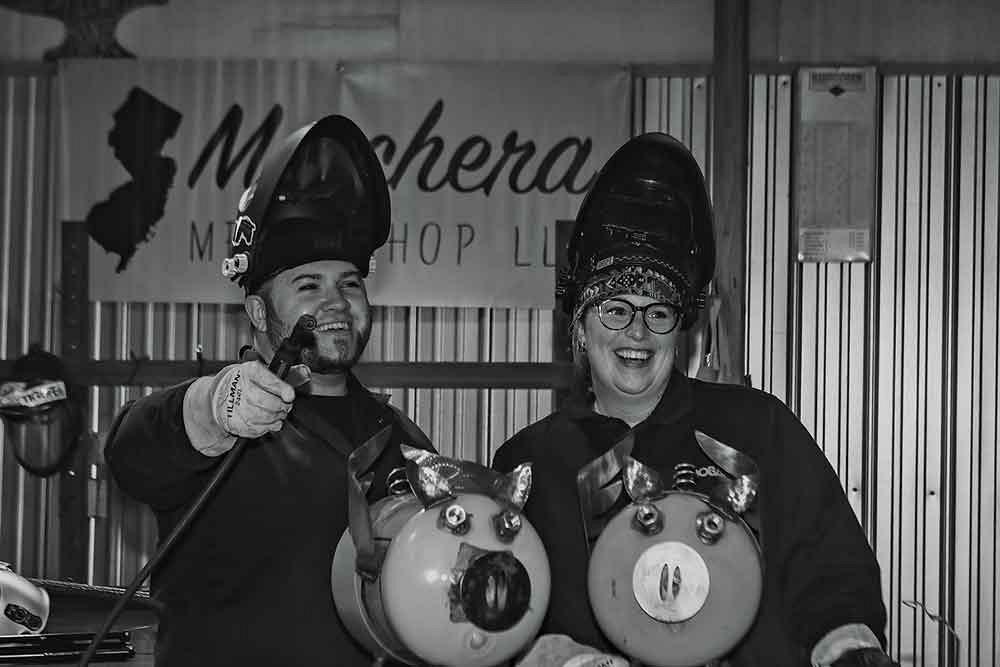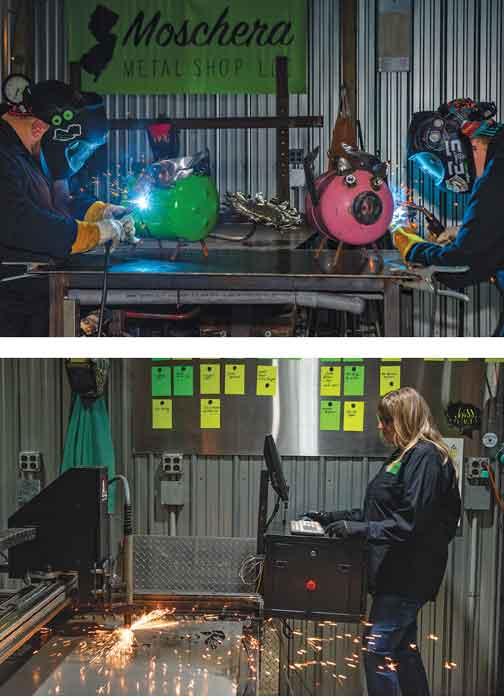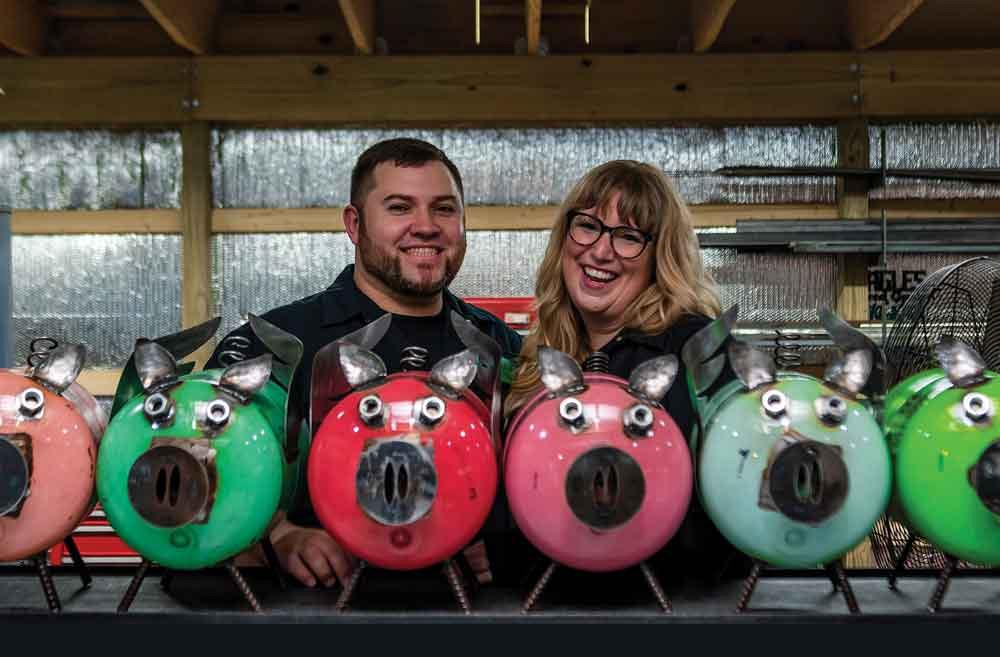- FMA
- The Fabricator
- FABTECH
- Canadian Metalworking
Categories
- Additive Manufacturing
- Aluminum Welding
- Arc Welding
- Assembly and Joining
- Automation and Robotics
- Bending and Forming
- Consumables
- Cutting and Weld Prep
- Electric Vehicles
- En Español
- Finishing
- Hydroforming
- Laser Cutting
- Laser Welding
- Machining
- Manufacturing Software
- Materials Handling
- Metals/Materials
- Oxyfuel Cutting
- Plasma Cutting
- Power Tools
- Punching and Other Holemaking
- Roll Forming
- Safety
- Sawing
- Shearing
- Shop Management
- Testing and Measuring
- Tube and Pipe Fabrication
- Tube and Pipe Production
- Waterjet Cutting
Industry Directory
Webcasts
Podcasts
FAB 40
Advertise
Subscribe
Account Login
Search
New Jersey couple finds surprising success with custom welding business
How a simple pig metal art project changed the course of Moschera Metal Shop
- By Amanda Carlson
- November 14, 2019
- Article
- Arc Welding

Joshua and Rachel Moschera, co-owners of Moschera Metal Shop, discuss where their business began, what it’s like to work with a spouse, and how a simple pig sculpture changed their business. Sara LaMachia Photography
Sparks fly between Joshua and Rachel Moschera both literally and figuratively. The couple owns and operates Moschera Metal Shop out of their home in Pemberton, N.J., where together they weld, cut, grind, design, and fabricate a variety of metal art sculptures and signs, complete custom TIG work, and take on whatever custom fab and welding job that might come their way.
Not only do they have fun doing it, they’ve found that spending time working together is quality time. And it all happened kind of by accident.
Joshua, 36, lives and breathes welding. He’s a full-time TIG welder for a biomedical research equipment company, but enjoyed doing custom jobs for others in his spare time. They started making a few metal art pieces just for fun, but they turned out so well that they garnered the attention of friends and acquaintances. People kept coming to him with special requests and he kept making items. That was 2012.
By early 2017, Rachel, a nonwelder, quit her full-time job and learned how to weld, hand cut, and paint to be more of a hands-on contributor in their burgeoning business.
Aside from having very little free time, if any, the couple is, for the most part, stunned at how successful their small business has become. Their signature item—colorful pig sculptures made out of reclaimed metal—is so popular that they have a hard time keeping them in stock at the local farmer’s market where they’re sold.
Even with all the success they’ve had, both Joshua and Rachel remain grounded and humble and have maintained their wry sense of humor (see the profile picture for Moschera Metal Shop's Instagram account, which features the two of them re-creating a welding version of the famous “American Gothic” painting).
The WELDER recently spoke to the couple about their business, how they are dealing with increased demand, the role social media has played in the shop’s growth, and what it’s like to work with a spouse.
TW: What led to trying your hand at metal art?
Rachel: I saw a couple of metal art pieces on Etsy—this is before we got into metal art—and I said to Josh, “Do you think you can make something like this?” and he said, “Sure!” So we started out with a few fun scrap metal pieces and horseshoe art. We never would have dreamed then that our shop would be what it is now. We were just doing it for fun and it just evolved over time.
Joshua: My first sculpture was a sunfish, and someone said, “Oh, I need to have one.” And then it snowballed into people making all kinds of requests for different things. There’s not a lot of people doing custom work or metal art in our area, so we were filling a niche that no one else was.

While the goal someday is for Joshua to work full time for Moschera Metal Shop, there’s no rush. They are growing the business slowly in hopes of building something that can last. Sara LaMachia Photography
Rachel: We sell locally to a little farm market, and the owners have been so incredibly supportive of us. They dreamed bigger for us than we dreamed for ourselves initially. The crowds that they draw in and their customer base are enormous for the small area that we’re in, so our presence there just grew and grew. It kept us busy, and the busier we got, the more exciting things we were making. We would do community events and someone would ask us to make them a custom piece. It just kept growing, and every request we got we just kept saying yes and taking on new challenges.
I’m still surprised every day. I can’t believe I’m part owner of a metal shop with my husband. When I’m asked what I do for a living, I still feel so lucky but yet so strange to say I’m a metal artist. It still hasn’t hit me.
TW: Josh, what was it like teaching Rachel how to weld?
Joshua: Welding is such a second-nature thing to me, like breathing, so I found it difficult teaching Rachel how to weld because I don’t really think about what I’m doing, I just do it. I can grab a TIG torch and weld anything and I don’t think about it.
When I first began teaching her how to weld, I went through all three processes way too fast. I showed her how to TIG weld stainless, and then I pulled out the stick welder and she was like, “Oh my gosh, what is going on here!” They’re so different from each other. And she was like, maybe you shouldn’t show me all of this all in one day. For me it was hard teaching because I had to grab the MIG welder and explain things to her while I was doing it because I don’t think about the X’s and O’s of it.
TW: Rachel, as a nonwelder, what were some of your struggles when you first started welding?
Rachel: I would ask Josh a question about the MIG welder or something specific to fabrication and he would say, “I don’t know, I just do it.” So I would have to keep asking. I’d try and restate the question and then I’d really watch him do it. I would get very nervous when he would watch me weld, which is silly because we’ve been together for so long. He’s my best friend, and he’s teaching me and just wants to help. But I was nervous.
I think what really helped—and don’t take this the wrong way, Joshua—but I’d weld on my own when he wasn’t around and build up confidence that way. I practiced by welding two square tubes together, and then I would show him my work. He’d give me feedback, like it should’ve been a little hotter or how I may have been going too slow. That helped me with my confidence and it helped him to teach me better. Yeah, there were tears, and I still do get really frustrated sometimes when I’m trying to figure out what’s going wrong, but I know enough now and he’s gotten better at teaching me now so that it’s a much quicker fix than it was before.
TW: What are some things you’ve learned as your business expanded?
Rachel: When you tackle a project with an end result in mind, there’s always going to be errors, but those errors force you to adjust and be resourceful. For instance, we painted everything by hand for a long time, and we still paint quite a bit, but the dry time was long, and we’d run into normal nature-related problems, like a leaf would fall onto a freshly painted project.

Early on Joshua assembled the pig sculptures with TIG. It was time-consuming, but as a self-taught TIG welder it was the process he knew like the back of his hand. When demand made it difficult to keep up using TIG, they invested in a couple of MIG machines and assembled them that way. Sara LaMachia Photography
We looked into powder coating and ended up creating a homemade powder coating oven. I found that it dries faster, is more durable, and the piece is out of the oven and into the box to be shipped out immediately. It’s another skill, and it definitely is another investment, but it’s a way to solve a problem. We try and outthink every problem that we come across.
We purchased a plasma table, and I was just so excited. I was up at 3 a.m. watching tutorials and taking notes. I downloaded the software and worked along with it so when the table finally did show up, we had a little bit of knowledge.
Joshua: We spent years hand drawing and hand cutting everything, so we feel like we’ve paid our dues. And we were ready for something to help us do things a little faster.
Rachel: Honestly, manual plasma cutting taught me a lot that carried over into the CNC plasma: how the speeds vary and how the amperage and the distance away from the sheet all play into how it’s going to cut. When you’re doing it by hand, it’s sort of the same—you need to control those aspects in order to get a clean cut.
TW: Joshua, how do you balance your side business with your full-time job?
Joshua: It can be tough. I go to work and put in my eight to 10 hours, and when I come home, I usually just go into the shop and keep working. We don’t just do art. We also do commercial signs or other custom welding and fabrication jobs, and we do all of the TIG welding for a small machine shop. Every day when I come home, I have something new or crazy to weld or work on. It’s tough to do all of this on top of a full-time job because it really locks up your nights and weekends.
Rachel: I try to have the shop prepared for whatever he needs to do when he gets home. I’ll prep the metal, clear off the work table, and get any fixtures or clamps out and get them on a cart ready to go. I usually have a schedule and I prioritize everything that we need to do, knowing that we have to be flexible because an emergency repair or a rush job could come in. But I do try and plan out each week and what we’ll be doing during the evenings and weekends.
TW: What has been your most popular piece of art?
Rachel: We’re probably best known for the metal art pigs made out of freon tanks, rebar, and scrap metal.
Joshua: Somebody asked me if I could make them a pig, so I got a tank and made a pig. And from there it just turned into a much bigger thing. When we first started making pigs in 2013, all we had was a TIG welder, so it was a total nightmare TIG welding all these pigs. We’ve made well over 800 pigs since 2013. Since then we’ve invested in MIG welding equipment, which makes it a lot easier.

Top. Rachel has had to learn how to weld and use metalworking machinery fairly quickly. During the day while Joshua was at work, Rachel would practice MIG welding techniques and then get his feedback on the beads when he got home. Bottom. The ArcLight Dynamics CNC plasma table is Rachel’s baby. Before it arrived she watched YouTube videos and worked along with their tutorials so they could hit the ground running once it was installed. Sara LaMachia Photography
TW: At what point did you realize these pigs were a hit?
Joshua: We took five pigs over to the farm market that we sell at and they were gone within a week. Like Rachel said before, the people that own the farm were some of our biggest supporters. They constantly asked us for more stuff and encouraged us to keep making more. So, we made 10 pigs and two weeks later they were gone. From there people started going crazy over them. We can’t go to a show without everyone freaking out about these pigs! I don’t understand what it is about them other than they make you smile.
Rachel: They’re quirky and cute, bright and vibrant, and it’s fun to display them in the yard or on the porch and give those areas a little pop of color. I think they’re reasonably priced for a piece of art that has a lot of character. They are a conversation starter and you get a lot of bang for your buck. There’s a lot of people out there who appreciate the fact that they’re made out of reclaimed materials. And then there’s the aspect that we are a husband and wife team, we’re a small business, we’re local artists, local welders, and they love supporting that too. I think the combination of all of those things has made these pigs a hit.
TW: Is it tough keeping up with the demand for the pigs?
Rachel: We’ve learned that we need to make 40 at a time for it to be efficient for us. We try and set the mood and call it a piggy party—we turn on some uplifting music and crank through them. Even though we aren’t really able to talk to one another—one’s grinding while the other is welding—we’re together and we try to have a little fun while we work.
The piggies require multiple days of advanced work and one solid day of welding. I’ll nest their little ears and snout into any sheet where there’s space. We grind those and have them ready to go. Then we cut the rebar legs and get them prepped. Their little snouts are a pipe, so we need to have them cut and prepped in advance so when it is time we can weld them together efficiently. And then on a day when the weather is nice, I’ll give them their clear coat.
TW: Has your presence on Instagram influenced or changed your business?
Rachel: We weren’t social media people before this at all. I got on Instagram on a whim and I started seeing things that welding accounts were posting, and that made me ask him questions like, “Hey, what is this? What does this mean?” And then he got started on it too.
Joshua: I thought it was cool that I could post my welds as well as the things I’ve built. One thing led to another and we became connected with a bunch of different people who had similar interests in welding. I realized pretty quickly how much everyone is on the same page in the weld community. We all want everyone to do well, and we all want to help each other out. A few of my posts with the things I’ve built have been shared by popular welding accounts like Michael Furick of Furick Cup, Benchmark Abrasives, and Blue Demon Welding Products. You just see the whole world is trying to come together under this metalworking umbrella.
Rachel: We’ve sold quite a bit of metal art as well as custom CNC cut pieces to other welders and fabricators who we’ve connected with over Instagram, and those people very well could have made them for themselves. They chose us as a sign of support for our business. I think that speaks volumes of the welding community on Instagram and how supportive everyone is of one another.

While they may be best known for their colorful piggy sculptures, Joshua and Rachel Moschera of Moschera Metal Shop can do so much more. Custom signs, custom TIG work, one-of-a-kind metal art sculptures or wall hangings—they welcome it all. Sara LaMachia Photography
TW: What are the pros and cons of working together?
Rachel: Finding that work/life balance is hard. We’re out in the shop almost every night after he gets home from his full-time job, and most of the weekends too. We make a point to schedule time just for ourselves and our family, but it’s got to be fluid. If a rush job comes in, then we’ve got to make that a priority. We’ve both gotten more used to that being the case, but it still kind of stinks when you have date night planned and a job comes in. All of a sudden date night goes out the window. But we try to adhere to it as best we can and to make time for ourselves outside of the shop, because we know that’s important too.
Joshua: Having very little spare free time is definitely a con. If I didn’t have my day job, then I’d have just a little more extra time. I mean, we would still have a lot of work to do, but making plans around your own schedule is easier than an employer’s. A pro is the fact that I get to see my wife every day and work with her. Occasionally we don’t agree, but that’s OK.
Rachel: Mondays are typically our off night. That’s usually when we’ve had enough after putting a lot of hours in over the weekend. Typically, Monday nights we have dinner together in the house and we don’t go out to the shop unless the need arises. There are times when the opposite is true. If we’re bickering about something in the shop, then it’s like, all right, this job needs to get done so we’re going to put our differences aside for the moment so we can go to work and get it done.
TW: Josh, do you ever envision working full time for Moschera Metal Shop?
Joshua: That is my goal, but the hardest part about that is walking away from health insurance. We’ve grown slow, and having a steady income has allowed us to do that the way we want to. We’ve never actually taken a business loan. Everything we have we built and worked for, we’ve paid for out of our own pockets. All of our welding machines and our CNC plasma table are here because we went out and got them ourselves with the money we’ve made.
Rachel: It’s nice to have that steady income the full-time job provides, and we definitely do depend on that right now. Hopefully sometime in the near future we’ll have enough of a cushion and investment in the business to have him here full time. We’re trying to be cautious right now. If Josh could put in his notice and stay home with me, that would be great. But we are choosing to be mindful and cautious and grow slowly. We have an end goal in mind, and we’re going to keep plugging away at it.
TW: What does it mean for the two of you to be doing this together?
Rachel: We are involved in so many facets of welding and so many applications—we don’t know when we get an order in if it’s going to be for a pig or a custom wall hanging or a commercial sign or a TIG job for a machine shop. It really doesn’t get old. To me it’s special because it’s not just about the sparks we create from MIG welding, plasma cutting, or grinding. It’s also about the love and connection Joshua and I have together.
About the Author

Amanda Carlson
2135 Point Blvd
Elgin, IL 60123
815-227-8260
Amanda Carlson was named as the editor for The WELDER in January 2017. She is responsible for coordinating and writing or editing all of the magazine’s editorial content. Before joining The WELDER, Amanda was a news editor for two years, coordinating and editing all product and industry news items for several publications and thefabricator.com.
About the Publication
subscribe now

The Welder, formerly known as Practical Welding Today, is a showcase of the real people who make the products we use and work with every day. This magazine has served the welding community in North America well for more than 20 years.
start your free subscription- Stay connected from anywhere

Easily access valuable industry resources now with full access to the digital edition of The Fabricator.

Easily access valuable industry resources now with full access to the digital edition of The Welder.

Easily access valuable industry resources now with full access to the digital edition of The Tube and Pipe Journal.
- Podcasting
- Podcast:
- The Fabricator Podcast
- Published:
- 04/16/2024
- Running Time:
- 63:29
In this episode of The Fabricator Podcast, Caleb Chamberlain, co-founder and CEO of OSH Cut, discusses his company’s...
- Industry Events
16th Annual Safety Conference
- April 30 - May 1, 2024
- Elgin,
Pipe and Tube Conference
- May 21 - 22, 2024
- Omaha, NE
World-Class Roll Forming Workshop
- June 5 - 6, 2024
- Louisville, KY
Advanced Laser Application Workshop
- June 25 - 27, 2024
- Novi, MI































